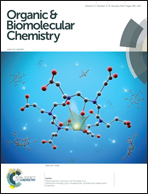More than one non-canonical phosphodiester bond in the G-tract: formation of unusual parallel G-quadruplex structures†
Abstract
In this article, we report an investigation, based on NMR and CD spectroscopic and electrophoretic techniques, of 5′TGGGGT3′ analogues containing two or three 3′-3′ or 5′-5′ inversion sites in the G-run, namely 5′TG3′-3′G5′-5′GGT3′ (Q350), 5′TG3′-3′GG5′-5′GT3′ (Q305), 5′TGG3′-3′G5′-5′GT3′ (Q035), 5′TG3′-3′G5′-5′G3′-3′GT5′ (Q353) and 3′TG5′-5′G3′-3′G5′-5′GT3′ (Q535). Although the sequences investigated contain either no or only one natural 3′-5′ linkage in the G-tract, all modified oligodeoxyribonucleotides (ODNs) have been shown to form stable tetramolecular quadruplex structures. The ability of the 3′-3′ or 5′-5′ inversion sites to affect the glycosidic conformation of guanosines and, consequently, base stacking, has also been investigated. The results of this study allow us to propose some generalizations concerning strand arrangements and the glycosidic conformational preference of residues adjacent to inverted polarity sites. These rules could be of general interest in the design of modified quadruplex structures, in view of their application as G-wires and modified aptamers.


 Please wait while we load your content...
Please wait while we load your content...